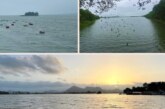The East African wetlands are in great danger due to human activities including human settlement. According to research cond ucted by John Kalisa from the University of Rwanda, there are gaps that have contributed to this situation. For instance, pollution of the environment around the wetlands area is on the rise.
ucted by John Kalisa from the University of Rwanda, there are gaps that have contributed to this situation. For instance, pollution of the environment around the wetlands area is on the rise.
Kalisa focused his case study on Nyabarongo urban wetlands in Rwanda that has been polluted by the waste discharged from the Gikondo industrial area.
According to Kalisa, the level of pollution is so bad that the Rwandan government was forced to relocate the industry in order to pave the way for the ecosystem restoration.
Nyaburongo wetlands are now surrounded by vegetation comprised of mainly food crops and planted forest. The main vegetation species found in the wetlands are papyrus, cattails and smartweeds.
But, examples from elsewhere across the region show that despite knowledge of the importance of wetlands, population increases day and night thus the human pressure on the exploitation of wetlands is expected to increase unless legal measures and actions are taken.
One of the results from research shows that there is a lack of knowledge among people involved in wetlands management.
Also, significant pressure on city wetlands can lead to ecosystem degradation where urban wetlands are overexploited and their lands converted to other uses.
Kalisa suggests that there is the need for renovation of wetlands in East Africa due to the significance of wetlands in urban land.
Vegetation around the wetlands acts as a filter funnel for both domestic and industrial waste which contributes to fresh water.
African wetlands include some of the most productive ecosystems in the world. Wetlands are the source of natural resources upon which rural economies depend on for fresh water, food, energy and medicine.
Africa still has a significant number of wetlands as compared to Europe and North America. However, the wetlands are endangered due to pressure from human activities which has drained agriculture.
In Kenya for example, the construction of dams in Kenya’s Tana River and Athi River have blocked upstream movement of the migratory fish species thus contributing to the decrease of populations of fish species.
The urban wetlands contribute to the supply of fresh water around cities. Some countries also use wetlands as tourist attraction sites such as the Okavango Delta in Namibia.
“These threats to our wetlands has a global effect to world’s bio diversity. Thus need for an urgent call to renovate our wetlands which lies in a good political governance through the introduction of policies that will control our Wetlands. This is by following the framework provided by the Ramsar Convention for supporting the conservation of wetlands and also to use it in a wise manner,” said Kalisa.
By Adlyne Wangusi



